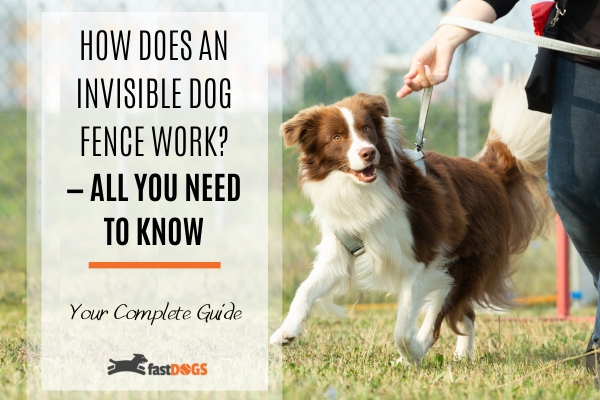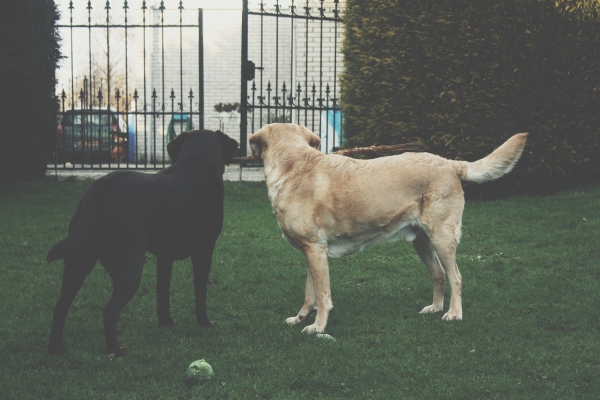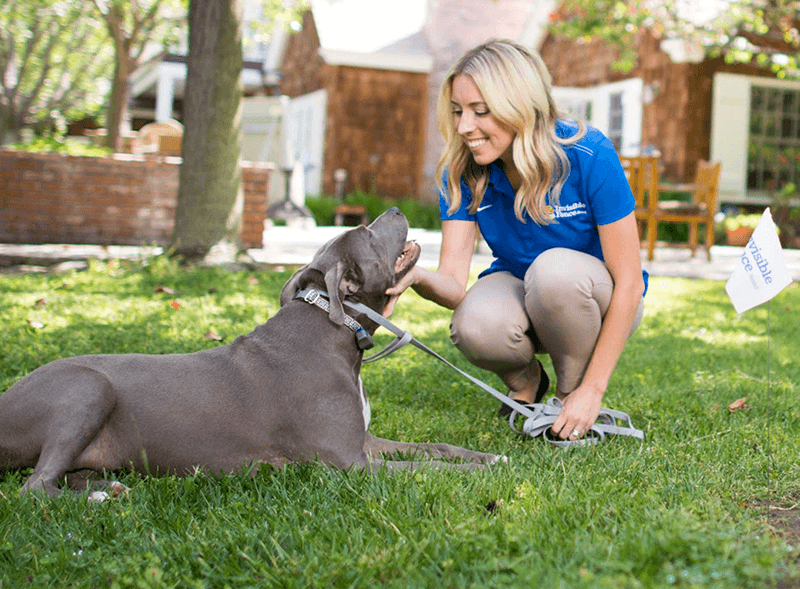Invisible Dog Fence: How Does it Work?

How Does an Invisible Dog Fence Work?
So how does an invisible dog fence work to keep your pet out of harm's way and give you some piece of mind?
If you don't have the time, space, or funds to invest in a more traditional containment method like a physical fence, an invisible dog fence is the next best thing. While it won't keep strangers and other animals at bay, setting it up costs far less and is more effective at preventing your pet from digging his way into the neighbor's yard.What Is an Invisible Fence for Dogs?
We all know our pets fulfill a significant role in our home. The bond we create with them can easily be compared to the relationship we have with other family members.
And, while we know that your mother-in-law is in no hurry to leave the house, our furry companions tend to get distracted and sometimes wander off, putting themselves in jeopardy.
One solution is an invisible fence.
In short. It’s a barrier for your bow-wow — you can’t see it, but it employs technology designed to prevent your dog from breaching your set perimeter.
So, do wireless dog fences work to keep our furry friends where they’re supposed to be?
Invisible Fence and How it Works — Considerations
Before we get into the detail, you first need to consider the following:
How much money are you willing to spend? — Proper budgeting is key.
How much time can you invest? — Some systems can be set up in a couple of hours, while others may take days.
What is the size of your property? — Not all invisible dog fences can cover larger properties.
What is the shape of your property? — Some invisible dog fence systems feature customizable layouts, while others are restricted to a certain shape.
Do you need a permanent or a portable solution? — There are many different types of invisible dog fences to choose from. Some are easier to take with you if you're frequently on the move.
Wired or Wireless Invisible Fence Controller System?
A wired invisible dog fence and the wireless options work in different ways. To answer the question of how does an electric fence work for dogs, we need to take a closer look at the different systems available.

Wired Dog Containment Systems
The wired electric dog fence method is an in-ground solution, but how does an underground dog fence work?
You will need to dig a trench and bury the wire in a custom layout that fits your yard and suits your needs.
The buried wire is then connected to a transmitter that should be located in a well-ventilated and easy-to-reach space like a garage, for example. This is a more permanent solution than the wireless counterpart and is more suited for stationary pet owners.
There are several default layouts available for wired invisible dog fences, but you can also get creative and make your own by creating a loop. Simply put, this means that the wire coming out of the transmitter box needs to go all the way around and back.
Exactly how a wired dog fence works is fairly simple. The transmitter sends a radio signal through the wires and establishes an invisible barrier. This acts as a deterrent for your pet and communicates with the collar around its neck.
The biggest advantage of the wired method is the flexibility when it comes to customizing the shape and size of the perimeter, also the initial price is somewhat lower. An important factor to bear in mind is that the total cost can go up exponentially if you plan to hire an installer, but a do it yourself invisible fence is cost-effective.
Pros of wired pet fence systems:
Perimeter can be customized.
Less expensive than fitting a physical fence.
Effective at preventing your dog from digging and escaping.
Set-up time is quick.
Can be used for other animals too.
Offers a solution where traditional fencing systems are lacking or unsuitable.
Cons of wired pet fence systems:
Professional installation can be expensive.
Will require you to dig into the ground.
Not a portable solution.
Doesn’t stop other people or animals from entering your property.
Will be ineffective if you don’t put the time in to train your dog properly.
Stubborn and determined dogs can still break through the fence.

Wireless Invisible Dog Barrier
The wireless dog fence method is better if you move frequently or love taking your pet and containment system with you when visiting family or friends — but how does it differ from a wired system, and do wireless dog fences work?
A wireless electric fence for big dogs and small canines comes with a transmitter that creates a circular-shaped boundary by emitting radio signals and a collar your dog wears around its neck. When your pooch pal tries to challenge the outer edge of the circle, the collar will warn him not to do so.
The biggest advantages of wireless dog fences are portability and the minimum effort required to set up the system. Going wireless is also great for inexperienced users because of how simple it is to use.
However, there are some downsides compared to an in-ground solution. The boundary zone diameter can be adjusted, but there is no way to have a customizable shape wireless dog fence.
Today there are many long-range products on the market, but don't expect to cover 20 acres of land with a wireless system. Also, if there are several large obstacles located in your yard, you might experience a decrease in signal strength.
Pros of wireless invisible dog fence:
Simple to install and set up.
Portable dog containment solution.
No digging required.
Cost-effective compared to traditional fencing.
Cons of wireless invisible dog fence:
Signal from the transmitter can be interrupted.
Radio signals may not cover a large enough area.
Can’t customize the shape of the boundary perimeters.
Training is required for it to be effective.

How Invisible Fence Works With Static Correction and Without
Both types of invisible dog fences are containment systems that give your faithful furry companion much-needed freedom and off-leash exercise while keeping him safely inside the boundary zone.
While they can roam freely inside the yard, the system reminds them that going out of bounds is unwanted behavior. And, the way it does this is through using static correction.
What is Static Correction?
Static correction is delivered through a collar your pet wears around its neck. More specifically — a pair of contact points that touch the neck dispatch a harmless and completely safe electric stimulation. To best describe it, imagine a slight tingling sensation, akin to an unexpected tap on the shoulder, something to surprise your pet and grab its attention.
Some models feature an adjustable intensity level, so you can tailor the static simulation to perfectly fit your pet's temperament. Most models have a tone-only mode too. This mode is typically used in the training process or as a warning sign when your pet enters the trigger zone before the static correction is applied.
A trigger zone determines the distance from the boundary line before your pet receives the audible beep. The width and adjustability of this area will depend on the product you choose.
However, regardless of which correction method you choose, there is one more essential element to how do invisible dog fences work — training your canine.How it Works Without Static Correction
If you would prefer to deter your dog by other means, there are alternatives to static correction.
You could use a system that enforces a boundary by using only sound or vibration. The principles are the same — as your dog nears your no-go zone, the collar will trigger. Yet, instead, they receive an audible warning, or a vibration, which should distract them, thus preventing them from venturing further.
To learn more, take a look at our guide on No-Shock Wireless Dog Fences.

Invisible Fence Dogs Training
Now that you know the different types of invisible fence for dogs and how they work. You will need to start thinking about how you’re going to train your dog for the fence to be as effective as possible.
Purchasing a wireless or wired invisible dog fence is easy, but training your dog requires focus, time, and effort. These containment systems are merely a tool that will teach your dog not to wander off without supervision.
We cannot emphasize enough how crucial it is to set aside at least an hour a day in the first week after installing the invisible dog fence for training purposes. It will be worthwhile, and you and your pup can even have some fun during the process.
Find out more — and prepare for invisible dog fence deterrent lessons, check out our guide on How To Train Your Dog With Invisible Fencing.Conclusion
As we’ve seen, invisible fences can be wired or wireless, plus you’ll also find static or nonshock correction techniques. And, as you know your dog better than anyone, you’re in the best position to decide which deterrent will be the most successful for you.
Yet, one factor gels everything together.
Without the proper training, none of these options will be effective for keeping your pooch within that boundary.
But, once you’ve made your choices, installed your system, and someone asks you — how does an invisible dog fence work? You’ll be able to explain it like a pro.
How Do Invisible Fences Work for Dogs? FAQs
How Well Do Invisible Fences Work?
An invisible fence is an effective solution for keeping your dog safe at home, and not wandering off into the neighbor's yard — and beyond. Unfortunately, while an invisible dog barrier will prevent your pet from escaping, it won’t stop other animals from coming onto your property.
However, without proper training, they won’t work as well. Failing to train your dog properly with the invisible fence equipment can limit the success of the system. On the whole, invisible fences are considered a safe and effective way of stopping your dog from escaping.
How Much Does an Invisible Fence Cost?
If you’re seeking a solution to your dog’s escapology tendencies, an electric invisible fence could be just that. Some systems cost less than $100, whereas more advanced invisible fences can set you back over $500.
Do Invisible Fences Work for Big Dogs?
Yes, an invisible fence will prevent large dogs from wandering away from home. There are invisible fence systems available that have been specifically designed with big dogs in mind. To learn more, read our guide on Wireless Dog Fences for Large Dogs.
Can a Dog Run Through an Invisible Fence?
If your dog wants to escape, they could find a way. That said, if the initial training is done correctly, it’s unlikely to be a problem for you.
